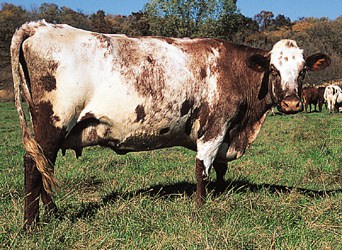Type the name of the breed you're looking for below
[wpdreams_ajaxsearchlite] Don't see the breed your're looking for? Click here and let us know!
Deoni cattle
| Place of Origin | India |
| Origin | The Deoni breed of cattle also sometimes known as Dongari (which means "of the hills"), has been evolved within the last 200 years. It is claimed that it has been developed from a strain descended from the mixture of Gir, Dangi and local cattle. A contribution from the Gir type of cattle is quite evident in the formation of the head and ears, and also of the horns to a certain extent. They also show a great similarity in general conformation and ruggedness to the Dangi cattle of Bombay State, an area which is not far from the Deoni cattle breeding area. |
| Purpose | Cows of this breed are moderately good milkers, yielding about 1135 kg in a lactation period of 300 days. Well-bred herds in farms yield on an average up to 1580 kg during the same period. (Sastry, 2005). Government farms in Maharashtra have reported that Deoni cows have an average age at first calving at 1586.9 ± 29.4 days, lactation milk yield of 859.1 ± 23.6 lit, lactation length of 280.5 ± 4.6 days, and dry period of 173.3 ± 7.4 days. (Singhal, 1980). The attainable yield per lactation in Deoni cows is reported to be 880 kg. The average fat content in the milk of Deoni cows was 4.3 percent. Deoni bullocks are good for heavy work and are particularly suitable for intensive cultivation. A bullock pair was able to pull the load of 10-11 quintals using wooden heavy cart with wooden wheels on kutcha (muddy) road. They are able to pull a maximum of 28-30 quintals of load using a light steel bullock cart with tyre wheels on tar roads for about 10–15 km. One pair of bullocks can pull the medium plough for about seven to eight hours a day and can plough about half an acre of land. The bullocks show their maximum potential at five to six years of age and maintain it up to 10–12 years of age. (Singh, 2002). |
| Appearance | The Deoni is a medium-sized animal which resembles the Gir in physical structure to a large extent. It is found in three colour variations; Wannera (clear white with black colour at the sides of the face), Balankya (clear white with black spots on the lower side of the body) and Shevera (white body with irregular black spots). The body is moderately developed and symmetrical with distinct muscles. Head is masculine, alert, broad and slightly convex. The colour of the head is black and white in Wannera and Shevera and completely white in the Balankya strain. The forehead is prominent, broad, slightly bulged and white in all the strains; ears are long and drooping with slightly curved tips; and eyes are prominent, bright and alert with black eyebrows. The hump is massive and well developed in males and small in females. The neck is short, strong and well developed. Dewlap is thick, pendulous, and muscular with folds. It is more pendulous in males than in females. The chest is deep and wide. The skin of these animals is thick and loosely attached to the body. The tail is long reaching below the hock with black and white switch. The udder is well attached and medium in size with squarely placed black teats. Bulls are characterized by blackish scrotums of a good size. The animals are docile and calm. The hair is soft and short. The cows have a fairly well-developed udder. The hooves are well-made and shapely and of a black colour. The body is massive and upstanding with considerable depth and gives an appearance of strength. |
| Horns | Horns are medium, thick, apart and emerge from the sides of the poll; tips of the horns are blunt. |
| Other Considerations | Known to be both good milk yielders and draft animals, the Deoni is considered as an important dual-purpose breed of cattle in India. These animals are quite popular in the tracts of former Hyderabad State which is now Telangana and adjoining districts of Karnataka and Maharashtra. Their crosses with Holstein and Jersey are very good milk yielders. Deoni cattle are hardy and well adapted to their breeding tract and constitute an important cattle genetic resource of India. |



